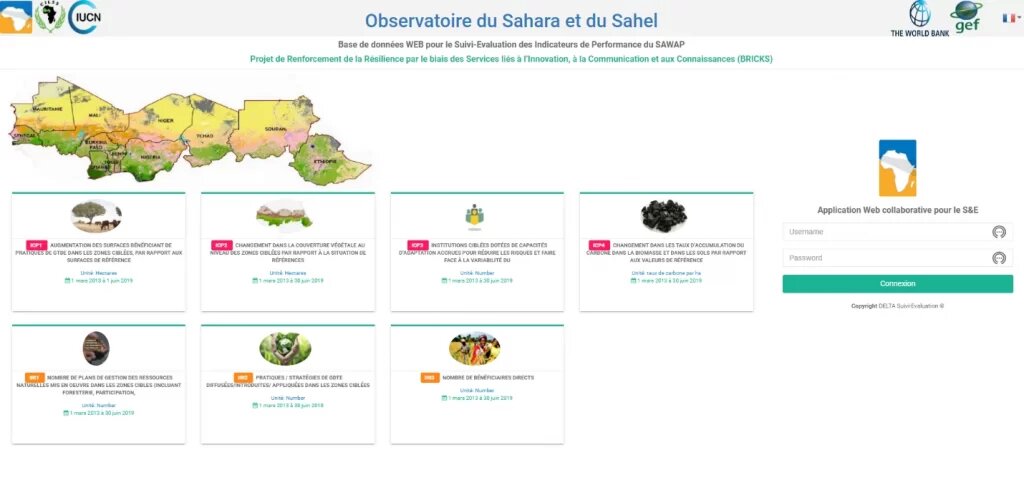The Sahara and Sahel Observatory (OSS) is an international scope organization with an African vocation which was created in 1992 and based in Tunis since 2000.
The OSS initiates and facilitates partnerships on common challenges related to the management of shared water resources, the implementation of international agreements on desertification, biodiversity and climate change in Africa.
Today, the OSS has 33 member countries (26 African countries and 7 non-African countries), 13 member organizations representing West, East and North Africa, UN organizations as well as 3 non-governmental organizations.
The OSS mission is to support its African member countries in the sustainable management of their natural resources in a particularly disadvantageous climate change context .
Challenge
The Sahara and Sahel Observatory (OSS) is an international organization focused on managing water resources, implementing international agreements on desertification, biodiversity, and climate change in the Sahara and Sahel region. They initiated the BRICKS project, a six-year, multi-country initiative aiming to build resilience through innovation, communication, and knowledge services.
The BRICKS project, backed by a substantial $1.1 billion fund, operates across 12 countries. The sheer size of the operation, its diverse geographical spread, and the complex scope of its objectives presented significant monitoring and evaluation (M&E) challenges. The OSS needed an M&E solution that would efficiently track the progress of the initiative, assess the effectiveness of their interventions, and provide data-driven insights for decision making. The traditional methods and tools were proving inadequate to handle the scale and complexity of the BRICKS project.
Solution
OSS adopted the DELTA Monitoring and Evaluation system to address the M&E challenges posed by the BRICKS project. The DELTA system is a cutting-edge M&E software designed to handle large-scale and complex projects like BRICKS. The system offers real-time monitoring capabilities, advanced data analytics, and easy-to-understand visualizations.
The software was employed to track progress across the 12 countries, enabling OSS to oversee all operations from a centralized location. DELTA allowed OSS to manage the allocation of resources, track project milestones, and report on key indicators. Its advanced data analysis and visualization tools provided OSS with actionable insights, making it easier to make informed decisions.
Outcome
With the implementation of the DELTA, OSS experienced significant improvements in project management and operational efficiency. The system enabled OSS to identify bottlenecks, monitor progress towards project goals, and generate reports swiftly. This resulted in efficient allocation of resources and improved decision making.
DELTA also helped increase transparency and accountability, with stakeholders able to see real-time data on project progress and resource use. This led to an enhanced reputation and increased trust among the partners and stakeholders of the BRICKS project.
The detailed data analysis provided by the DELTA system allowed OSS to evaluate the impact of their interventions accurately. This informattion is crucial in determining future strategies and replicating success in other regions.
Conclusion
The Delta Monitoring system for monitoring and evaluation proved instrumental in tackling the substantial challenges posed by the vast scale and complexity of the BRICKS project.
By providing advanced monitoring and evaluation tools, DELTA enabled OSS to manage resources effectively, make informed decisions, and assess the impact of their initiative.
The OSS’s success in the BRICKS project is a testament to DELTA’s capability to support large-scale, complex, and geographically diverse projects.
Summary
Challenge
The Sahara and Sahel Observatory faced substantial monitoring and evaluation challenges with the BRICKS project, a vast, multi-country initiative spanning 12 countries, backed by a $1.1 billion fund.
The scale, geographical diversity, and complexity of the project’s objectives necessitated a comprehansive M&E solution. Traditional M&E methods and tools fell short in managing the project’s magnitude and intricacy.
Solution
To address the M&E challenges presented, the OSS implemented the DELTA Monitoring and Evaluation system.
Delta Monitoring offered real-time monitoring, sophisticated data analytics, and accessible visualizations. Using DELTA, the OSS could centrally track initiatives progress across 12 countries, manage resource allocation, track milestones, and generate crucial reports.
Outcome
The deployment of the DELTA M&E system resulted in notable enhancements in the OSS’s management efficiency and operational efficacy.
It enabled rapid pinpointing of operational impediments, facilitated monitoring of advancement towards objectives, and accelerated report generation, leading to optimized resource distribution and enhanced decision-making processes.
DELTA’s comprehensive data analytics capability provided OSS with precise assessments of the impacts of their interventions which is essential for strategizing future initiatives and replicating successful methodologies across different regions.



RESOURCES
CONTACT
- contact@delta-monitoring.com
- (+1) 514 779 1591


